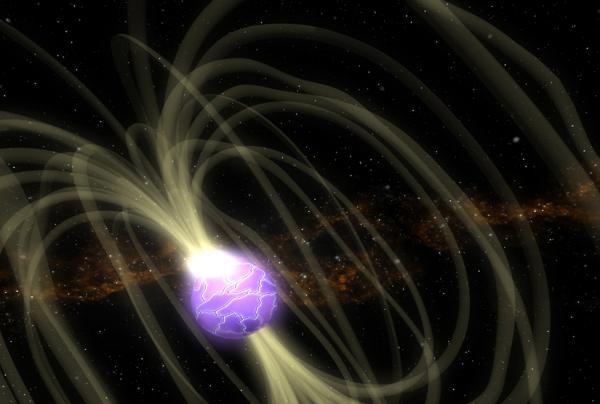According to NASA's Swift satellite, many radioactive streams are emitted from a rare object, which is known as a short gamma radio station (SGR soft gamma). Using the European Aviation Agency's XMM-Newton satellite and the International Astrophysics Laboratory, astronomers have an in-depth study of this radioactivity.
In the last decade, SGR 0501 + 4516 is the first object of this type to be discovered and the fifth SGR to be identified. Nanda Rea from the University of Amsterdam, who led the study, said: 'Some objects are powerful, there are also objects that sleep for 10 years or longer. Therefore, there is a basis to predict that there are still many objects of this kind that we do not know yet. '
According to astronomers, the explosion of SGRs arises from the strongest magnetic objects in the universe are magnetic stars . Magnetic stars are a special form of neutron stars with super strong magnetic fields. (The neutron star is a highly compressed material part after the explosion). The magnetic field of a magnetic star is 100,000 billion stronger than the earth's magnetic field. A star from a distance of about half the distance from the earth to the moon will disable the magnetic strip on all credit cards on earth. Kenvin Hurley, a member of the research team at the University of California, Berkeley, says 'Star words allow us to learn about the harsh natural conditions that cannot be found on Earth.' It is thought that both SGR and a group of high-energy neutron stars - called anomalous X-ray pulsars - are magnetic stars. However, astronomers have only known about 15 such cases so far.
 SGR 0501 + 4516 is one of the word stars. The remaining physical part of a star has the strongest magnetism in the universe. Today, only 15 stars like that are known. (Photo: NASA / Goddard Space Flight Center Conceptual Image Lab)
SGR 0501 + 4516 is one of the word stars. The remaining physical part of a star has the strongest magnetism in the universe. Today, only 15 stars like that are known. (Photo: NASA / Goddard Space Flight Center Conceptual Image Lab)
SGR 0501 + 4516 is about 15,000 light-years away from the earth. People only discovered it when there were bursts from there. Astronomers believe that the unstable shape of the star magnetic field gives rise to that explosion.'Once the magnetic field regains a more stable shape, this excessive activity will end and the star comes back to quiet and emitted weakly,' Rea said.
Twelve hours after the Swift satellite located the SGR 0501 + 4516, the XMM-Newton device started the most detailed study of the magnetic star boom. In 4 months, hundreds of small explosions took place. Just 5 days after the first explosion, INTEGRAL detected X-rays emitted from the object that the XMM-Newton device could not see. It was the first time that the short emission of X-rays was detected in an explosion of SGR. This emission disappeared after 10 days of the explosion. This result is published online on the Royal Astronomy Society's June 15 edition.
The team plans to observe SGR 0501 + 4516 more closely with XMM-Newton device. They hope to detect objects in a static state to investigate the period after its bursts.
 Van Allen's belt and evidence that the Apollo 11 mission to the Moon was myth
Van Allen's belt and evidence that the Apollo 11 mission to the Moon was myth The levels of civilization in the universe (Kardashev scale)
The levels of civilization in the universe (Kardashev scale) Today Mars, the sun and the Earth are aligned
Today Mars, the sun and the Earth are aligned The Amazon owner announced a secret plan to build a space base for thousands of people
The Amazon owner announced a secret plan to build a space base for thousands of people